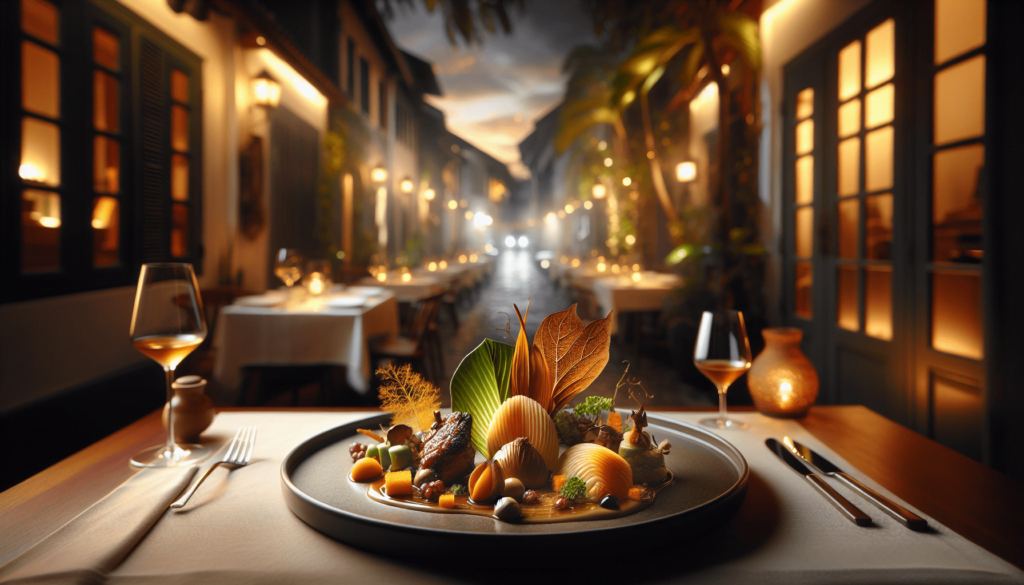Embark on a delectable adventure with “Indulging in Epicurean Escapes: A Gastronomic Journey Abroad,” where your taste buds will traverse through an array of global delights. Imagine savoring the rich, velvety flavors of authentic French cuisine in a quaint Parisian bistro, or the vibrant, fiery spices of street food in bustling Bangkok markets. This article explores the fascinating history behind these culinary traditions, delves into contemporary food trends, and offers a detailed analysis of how these gastronomic experiences shape and are shaped by cultural interactions. Through vivid examples and thoughtful comparisons, you’ll gain a comprehensive understanding of the profound impact of food as a central element of cultural identity and global exchange. Bon appétit!
Table of Contents
Indulging in Epicurean Escapes: A Gastronomic Journey Abroad
Overview
Have you ever dreamt of traveling the world, not just for the iconic sights or the rich history, but for the extraordinary culinary experiences that lie beneath? Welcome to your guide on indulging in epicurean escapes: a gastronomic journey abroad. In an increasingly interconnected world, our palates have become more adventurous, longing for tastes and experiences that transcend geographic boundaries. Culinary tourism, the practice of exploring a destination through its food, has become a vibrant trend in travel. It offers a delectable way to understand different cultures and their histories while savoring delicious dishes that tell unique stories.
Thesis Statement
In this article, we will embark on an epicurean escape, uncovering how food not only nourishes the body but also serves as a vital link to culture and history. Through detailed exploration, we aim to highlight the essence of gastronomic journeys abroad and their increasing appeal in the realm of travel.

This image is property of images.pexels.com.
Historical Context
When you think of traveling for food, you are partaking in a ritual as old as human civilization itself. Historically, trade routes such as the Silk Road and the Spice Route were established primarily for the exchange of food and spices. Ancient empires from the Romans to the Chinese recognized the power of food in diplomacy and cultural exchange. Banquets, feasts, and festivals were (and still are) essential in forging alliances and showcasing hospitality.
Consider the influence of explorers like Marco Polo and Christopher Columbus, whose voyages led to the introduction of new foods in their home countries. Tomatoes, potatoes, and various spices, once exotic, have since become staples, altering culinary landscapes forever.
Current Trends
In today’s world, culinary tourism is a flourishing segment within the travel industry, capturing the hearts of adventurers and food enthusiasts alike. According to recent trends, there is a noticeable increase in travelers who prefer to plan their trips around food experiences. From street food tours in Bangkok to wine-tasting tours in Tuscany, the search for authentic culinary experiences is a driving force in travel planning.
Here are some prevailing trends in gastronomic journeys:
- Farm-to-Table Experiences: Travelers are increasingly interested in understanding the source of their food, favoring farm visits and organic dining.
- Food Festivals: Celebrations like Spain’s La Tomatina and Germany’s Oktoberfest draw crowds in the thousands, eager to participate in and taste local traditions.
- Cooking Classes: Learning to cook local dishes offers a hands-on way to appreciate and replicate the essence of a culture back home.
- Michelin Guide Travels: Some travelers make it their mission to dine at Michelin-starred restaurants worldwide, turning their journey into a series of high-end culinary experiences.

This image is property of images.pexels.com.
Key Concepts and Definitions
Let’s clarify some terms to ensure we’re on the same page:
- Culinary Tourism: Travel directed towards experiencing the food of a destination.
- Epicurean: Relating to the enjoyment of good food and drink.
- Gastronomy: The art or science of good eating, particularly the study of food and culture, with a particular focus on gourmet cuisine.
Detailed Exploration
Culinary Exploration: The Heart of Epicurean Escapes
The joy of culinary tourism lies in its diversity. Each meal becomes a narrative, each flavor a page in the vast book of cultural heritage. Here’s a comprehensive look at elements that epitomize a gastronomic journey.
Street Food: The Pulse of a City
Street food acts as the heartbeat of many cities around the world. Imagine wandering through the bustling streets of Taipei during the night market, inhaling the tantalizing aroma of stinky tofu, or savoring a plate of pad Thai from a Bangkok food stall. These inexpensive delicacies offer authentic tastes that reflect the local populace’s daily life and traditions.
Fine Dining: Savoring Artisan Creations
On the other end of the spectrum lies fine dining. Restaurants with Michelin stars often become pilgrimage sites for culinary enthusiasts. Whether it’s the molecular gastronomy of Spain’s El Bulli or the farm-to-table freshness of California’s French Laundry, fine dining experiences offer tales of innovation, luxury, and art.
Cooking Classes: Gaining Hands-On Experience
Learning to cook a local dish provides not only entertainment but educational value as well. Imagine kneading dough for a rustic Italian pizza or rolling sushi under the guidance of a Japanese chef. These experiences are insightful and personal, imbuing your travel memories with newfound skills you can showcase back home.
Example 1: The Influence of French Cuisine
French cuisine has long been heralded as the epitome of gastronomic finesse. The story of French culinary arts reflects a tale of historical evolution and cultural pride.
Case Study: The Role of Auguste Escoffier
Escoffier, a legendary figure in French cuisine, revolutionized the professional kitchen and brought French cuisine to the international stage. His methods introduced the brigade system in kitchens, streamlining operations and bringing a level of professionalism that was revolutionary. The emphasis on sauces, as a key element in a dish, and the codification of recipes into the culinary bible, “Le Guide Culinaire,” are testaments to his enduring influence.
Culinary Tourism in France
Tourists flock to France not just for the Eiffel Tower but also for the chance to savor authentic French pastries in a quaint Parisian café or enjoy a rich Coq au Vin in the vineyards of Bordeaux. Wine tours in the Champagne region, cheese-tasting in Normandy, and truffle hunts in Provence are quintessential examples of how France has turned its culinary heritage into an unparallel attraction.
Example 2: The Vibrancy of Thai Street Food
Contrasting the refined elegance of French cuisine, Thai street food offers bold, exciting flavors that entice travelers from around the globe.
Bangkok: A Culinary Powerhouse
Bangkok’s street food culture is a paradise for any foodie. Whether it’s the spicy tang of a green papaya salad or the comforting warmth of a bowl of tom yum soup, the city offers a plethora of choices that are both delicious and accessible.
Culinary Tours in Thailand
Visitors can embark on guided street food tours, exploring bustling markets like Chatuchak, savor local desserts like mango sticky rice, and even attend cooking classes to learn how to recreate these flavors at home. The communal sense of enjoyment and the captivating hustle and bustle of the markets offer an intoxicating experience.
Comparison of Different Perspectives
Understanding gastronomic journeys requires acknowledging the differing perspectives and approaches individuals may have.
Authenticity vs. Innovation
While some travelers seek traditional, authentic flavors reminiscent of a grandmother’s kitchen, others look for innovative, modern twists that elevate classical dishes to avant-garde status. For example, while some may prefer a traditional Italian trattoria, others might gravitate towards a contemporary spin at a place like Osteria Francescana.
Simplicity vs. Complexity
Another viewpoint divides enthusiasts who appreciate the simplicity of dishes—like the Italian spaghetti aglio e olio, requiring minimal ingredients and techniques—from those enamored by the intricate, multi-component dishes found in haute cuisine.
Impact Assessment
Evaluating the impact of these perspectives offers insightful revelations.
Cultural Preservation
Authentic culinary tourism helps preserve cultural heritage by valuing traditional recipes and cooking methods. For instance, Unesco’s recognition of the “gastronomic meal of the French” as an Intangible Cultural Heritage has helped preserve and promote traditional dining practices.
Culinary Innovation
The pursuit of innovation leads to exciting new gastronomic experiences, drawing curious travelers and fostering a spirit of creativity. These evolutionary cooking methods, such as those involving molecular gastronomy, push the boundaries of flavor, texture, and presentation, offering diners novel experiences.

This image is property of images.pexels.com.
Future Directions and Implications
Predictions
Looking ahead, culinary tourism is poised to expand, embracing sustainability and inclusivity. Future culinary travels may focus more on:
- Sustainable Dining: Increasing attention to environmental impacts will likely lead to a preference for eco-friendly dining practices and farm-to-table models.
- Inclusivity: Dietary preferences and restrictions (vegan, gluten-free, etc.) will further integrate into culinary offerings, making travel more accessible and enjoyable for all.
- Technological Integration: Augmented reality dining experiences and virtual cooking classes may become new facets of culinary tourism, bridging physical and digital experiences.
Implications
The rising interest in gastronomic journeys brings profound implications:
- Industry Growth: With increased interest, local economies benefit through tourism dollars spent on food-related activities, bolstering communities.
- Cultural Exchange: These journeys facilitate a deeper cultural exchange, promoting understanding and appreciation of diversity through the universal language of food.
Conclusion
Recap
The delightful essence of epicurean escapes embodies not just the flavors and aromas of diverse cuisines but also the rich stories, traditions, and histories they carry. From the rustic charm of street food to the refined elegance of Michelin-starred dining, gastronomic journeys offer a comprehensive, sensory experience that enhances our understanding and appreciation of different cultures.
Final Thought
So, where will your next culinary adventure take you? Will you find yourself savoring a hearty bowl of ramen under the neon lights of Tokyo, or relishing a decadent chocolate croissant in a quaint Parisian café?

Engagement
We’d love to hear about your own epicurean escapes! Share your experiences, favorite dishes, or culinary tips in the comments below. Feel free to share this article with fellow food enthusiasts and explore more resources to fuel your culinary curiosity.
Credible Sources
- Escoffier, Auguste. “Le Guide Culinaire.”
- Richards, Greg. “Gastronomy, Tourism, and the Media.”
- Culinary Tourism Alliance. “Food Tourism 101.”
- The World Tourism Organization (UNWTO). “Global Report on Food Tourism.”
Embark on your journey with an open heart and an eager palate, and remember, every dish tells a story, and every meal is an adventure waiting to happen. Bon appétit!

Related site – A Gastronomic Delight: Y Our Epicurean Journey Begins
Exploring the Diversity of Global Gastronomy: From Street Food to Fine Dining
